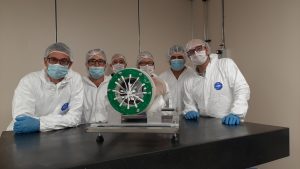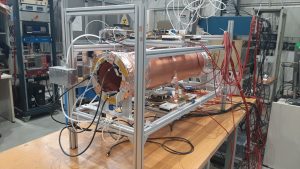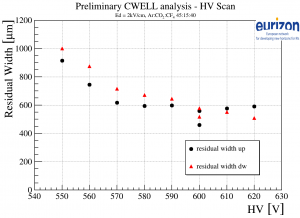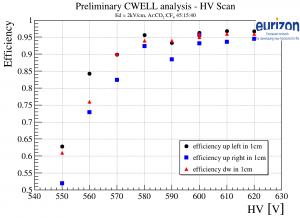
Within the scope of EU project EURIZON, the LNF Detector Development Group and INFN-Fe have successfully completed the construction of a novel detector: a pioneering low-mass modular Inner Tracker developed for low-momentum electron-positron colliders, exploiting the innovative Cylindrical µ-RWELL (C-RWELL) technology. This resistive Micro Pattern Gas Detector (MPGD) features a cylindrical structure, consolidating the amplification stage, resistive layer, and readout board into a single flexible element, enabling non-planar geometry.
The most significant milestone in the project was the assembly of the C-RWELL: the curvature of the µ -RWELL circuit was obtained by coupling the circuit to a cylindrical shell (looking like a roof tile) made of MILLIFOAM®, a special low-density material chosen to fulfil the request for a low material budget detector. The coupling was done by means of an epoxy layer cured under vacuum bag. The detector is then composed of three “roof-tiles”.

Once installed on the cylindrical anode structure, the detector was completed by soldering the high-voltage connections. Precision insertion of the anode structure within the cathode was facilitated by a thoughtful design of a novel structure with aluminum profiles and a guiding metallic tube.
The subsequent closure of the detector finalized component integration, ensuring a sealed and cohesive structure. This was complemented by the installation of high-voltage distribution and Front-End Electronics boards.
The successful validation of the low-mass inner tracker concept based on C-RWELL technology was achieved, based on detector performance preliminary results evaluated with cosmic-ray muons: efficiency up to 97% and estimated space resolution down to 400 µm.
The project clearly demonstrated advantages (robustness, modularity and adaptability to non-planar geometries) over previous technologies. The collaboration with LOSON Srl was fundamental to access the world of composite materials, thanks to which it was possible to realize such low mass cylindrical structure. These results represent a significant achievement in demonstrating the functionality and reliability of the first and unique C-RWELL detector.
This project has received funding from the European Union’s Horizon 2020 research and innovation programme under grant agreement No. 871072


 INFN-LNF Laboratori Nazionali di Frascati
INFN-LNF Laboratori Nazionali di Frascati